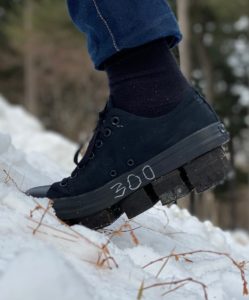By Prokopios Antonellis
Walking on level ground demands little effort, but walking on grades quickly becomes challenging. Is it possible to minimize energy expenditure with shoe outsoles that offset downhill or uphill grades? We investigated the interaction effects of outsole geometry and grade on the metabolic rate and biomechanics of walking.
We developed a modular shoe that allows for altering the inclination of the foot relative to the ground. Shoe height differences were between 3 to 6 cm between the heel and toe region. We tested the effect of these different shoe inclinations on the metabolic rate and biomechanics of downhill and uphill walking at different grades, including level walking. Each condition lasted 5 minutes. We expected that offsetting the downhill or uphill grade would minimize metabolic rate. Remarkably, shoes that exactly offset the grade did not minimize the metabolic rate. Instead, shoes that compensated for about half of the grade (by using a raised heel for uphill walking and a raised toe for downhill walking) proved to be optimal. Shoe inclination primarily influenced (distal) ankle joint parameters (e.g., soleus activity, ankle moment, and work rate), whereas grade influenced (whole-body) ground reaction force and center-of-mass parameters, as well as (distal) ankle joint parameters.
Walking on uneven terrain with uphill and downhill sections, the metabolic rate is mostly affected by the uphill portions. As such, it could be advantageous to use shoes with a slight downward shoe inclination in these situations (Figure). It could also be possible to design shoes that allow for changing the inclination depending on the grade of the terrain to avoid repetitive overstretching of the calf muscles. Our results could further explain some of the differences in metabolic rate between walking on stairs and ramps at an equivalent average grade. Current construction guidelines recommend the use of ramps for low grades and the use of stairs for higher grades. The benefit of shoes that partially offset the average grade, as observed in the current study, might, therefore, be seen as indirect evidence of the benefit of stairs. Overall, these modular shoes could be used as a research instrument to optimize parameters other than metabolic rate, such as minimizing joint loading to prevent injuries or assisting with walking on rolling terrain.

Figure: Modular shoe that allows for offsetting uphill and downhill grades. The shoe shown here has a downward outsole configuration for facilitating uphill walking. The figure evokes a potential outdoor application. The experiments were conducted during indoor walking between treadmill grades of -6° and 6°.
Publication
Antonellis, P., Frederick, C. M., Gonabadi, A. M., & Malcolm, P. (2020). Modular footwear that partially offsets downhill or uphill grades minimizes the metabolic cost of human walking. Royal Society open science, 7(2), 191527. https://doi.org/10.1098/rsos.191527
About the Author

Prokopios Antonellis
Department of Biomechanics and Center for Research in Human Movement Variability, University of Nebraska at Omaha, Omaha, Nebraska, United States of America
Prokopios is a Ph.D. candidate and doctoral research assistant at the University of Nebraska at Omaha. He investigates the mechanics and energetics of human locomotion with interacting biological and device components. His overall research goal is to give clinicians new variables to target during rehabilitation based on the human-device interaction.
Copyright
© 2020 by the author. Except as otherwise noted, the ISPGR blog, including its text and figures, is licensed under a Creative Commons Attribution-ShareAlike 4.0 International License. To view a copy of this license, visit https://creativecommons.org/licenses/by-sa/4.0/legalcode.
ISPGR blog (ISSN 2561-4703)
Are you interested in writing a blog post for the ISPGR website? If so, please email the ISGPR Secretariat with the following information:
- First and Last Name
- Institution/Affiliation
- Paper you will be referencing


